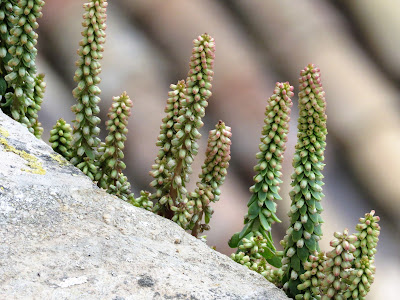Navelwort gazing at Spanish walls
It took me a while to track down the name of this Umbilicus rupestris. It should have been easy. The the species name means growing on or among rocks, which it does, and 'umbilicus' means navel, and is often used in botany to refer to roundish, saucer-like leaves (as you can see in the next picture).
So it's a helpful botanical name. Common names include Navelwort and Penny Pies. Navelwort is again a reference to the leaf shape, with wort being a general term for a plant, particularly one used for medicine or food. Penny Pies, or even Wall Pennywort, presumably also refer to the succulent leaves which might look a bit like small meat (or fruit) pie.
This is a fleshy plant, in leaf and flower, and so fits nicely in the family Crassulaceae along with better known succulents such as Crassula, Echeveria and Kalanchoe. Having the capacity to hold some extra water inside the plant would certainly be an advantage when you live a long way from ground water.
My plants are from Spain, on walls and church parapets. This is the view from the parapet supporting the plant at the top of this post, in the town of Ronda.
The flora of buildings is an intriguing one and hardly done justice here, but I'll a few more sightings from my recent travels in southern Europe. This next one is is Sarcocapnos, probably Sarcocapnos enneaphylla, another rock wall plant with saucer-shaped leaves. Presumably this leaf shape is a help in gathering and channeling water to roots jammed into a rather dry crevice.
Sarcocapnos is a close relative of a more familiar group of plants, the Fumitories, often weedy in Australia. I found one of them at the edge of the same church roof as the Navelwort. I’m calling it Fumaria agraria.
I thought at first the species name was nod to this plants chalky, calcium-rich substrate, limestone. In fact, a calcitrapa is a four-pronged device laid on roads to stop horses, people or in more modern time vehicles with pneumatic tires. It is better known today as a caltrop. There is a prickly genus of thistles with this name, but in our case I can't see the allusion.
This one is, I think, a Snapdragon of some kind - a species of Antirrhinum. It was up high, among the saints, so well out of my reach.
The showiest plant I saw on a wall was Capparis spinosa, the Caper Bush. Capparis is one of those plant groups where I have a blind spot. I see it every few years but can never remember what it is. Thankfully Jana Bate, a well trained horticultural teacher from TAFE Ryde in Sydney, was on hand to 'remind me' of this one.
Other wall-dwelling plants destined for bigger things, like this edible Fig, Ficus carica.
But to finish, not all rock and stone loving plants are adventitious. These wall-hugging creepers (cultivars of Ivy; Hedera helix) were of course very deliberately planted in their concrete pots, but now very much 'own' the stonework.












Comments